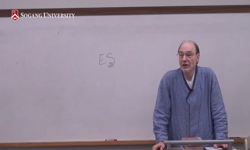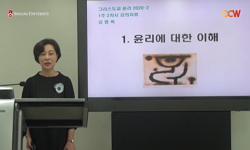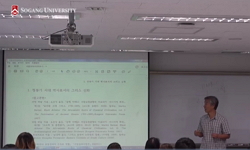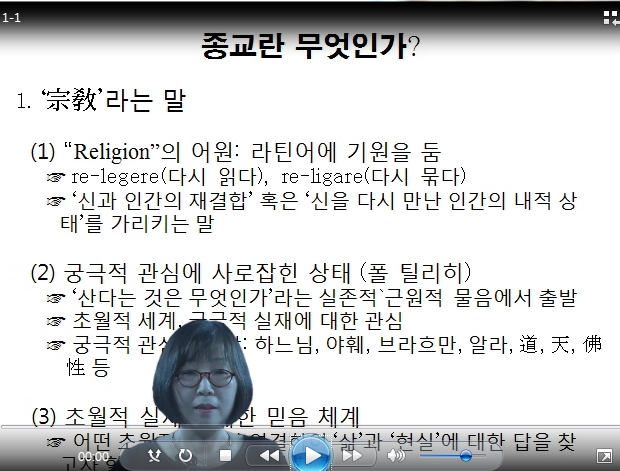김기동의 그리스도교 본질 이해는 단선적이지 않고 다층적이고 다면적이다. 즉, 그리스도교 본질 이해를 다양하게 이해하고 제시한다는 것이다. 그는 크게 그리스도교 본질을 네 가지로 본...
http://chineseinput.net/에서 pinyin(병음)방식으로 중국어를 변환할 수 있습니다.
변환된 중국어를 복사하여 사용하시면 됩니다.
- 中文 을 입력하시려면 zhongwen을 입력하시고 space를누르시면됩니다.
- 北京 을 입력하시려면 beijing을 입력하시고 space를 누르시면 됩니다.
김기동의 그리스도교 본질 이해 연구 : 슐라이에르마허, 칼 바르트, 위르겐 몰트만과의 비교 연구 = A Study on Ki-Dong Kim's Understanding of the Essence of Christianity : A Comparative Study on Schleiermacher, Barth, Molmann
한글로보기https://www.riss.kr/link?id=T11297204
- 저자
-
발행사항
서울 : 베뢰아국제대학원대학교, 2008
-
학위논문사항
학위논문(석사) -- 베뢰아국제대학원대학교 , 신학과 목회신학 전공 , 2008. 2
-
발행연도
2008
-
작성언어
한국어
- 주제어
-
발행국(도시)
서울
-
형태사항
74 p. ; 26cm
-
일반주기명
지도교수:최석
- 소장기관
-
0
상세조회 -
0
다운로드
부가정보
국문 초록 (Abstract)
김기동의 그리스도교 본질 이해는 단선적이지 않고 다층적이고 다면적이다. 즉, 그리스도교 본질 이해를 다양하게 이해하고 제시한다는 것이다. 그는 크게 그리스도교 본질을 네 가지로 본다.
첫째로 그리스도교 본질로서의 삼위일체 신론이다. 그는 삼위일체 신론을 담보하는 것이 그리스도교가 그리스도교 되게 하는 것으로 파악한다.
둘째, 그리스도교 본질로서의 그리스도다. 예수 그리스도에 대한 신앙고백이 확보되지 않은 것은 결코 그리스도교가 될 수 없다. 최근 종교다원주의는 ‘신론 중심적 신학’을 지향하고, ‘그리스도 중심적 신학’을 포기하려는 입장에 서 있다. 여기에 제2차 바티칸 공의회에서 칼 라너(Karl Rahner)의 ‘익명의 그리스도인 개념’을 수납한 가톨릭 교회 역시 이 입장에 서 있다고 볼 수 있다. 하지만 김기동은 이러한 흐름에 반대하며, 그리스도교가 참된 자기의 정체성을 가지기 위해선 절대적으로 그리스도에 대한 신앙고백이 담보되어야 한다고 본다.
셋째, 그리스도교 본질로서의 성령의 현재적 역사로 말미암아 나타나는 이적의 현재성이다. 김기동은 아무리 그리스도교가 삼위일체와 그리스도에 대한 신앙고백과 선명한 신학적 이해가 있다 할지라도, 성령의 현재적 역사로 말미암은 이적의 현재성이 부인된다면, ‘그리스도교의 종교화’는 빠르게 진행될 것이라고 본다. 이적의 현재성을 통해 하나님의 실체를 보여줄 수 없는 그리스도교는 ‘지적이고 문화적 그리스도교’이지 ‘능력 있는 그리스도교’는 아닌 것이다. 16세기부터 20세기 후반까지 서구 그리스도교회의 모습은 교리만 앙상하게 남은 ‘무능한 그리스도교’를 단적으로 보여주었고, 그로 인해 그리스도교는 더 이상 ‘서구의 종교’로도 인정받지 못한 실정이다. 그러므로 그는 이적의 현재성을 그리스도교의 본질로 이해한다.
넷째, 그리스도교 본질로서의 계시 신앙이다. 그는 하나님의 말씀에 근거하지 않는 그리스도교는 자연종교 혹은 신비주의로 취급한다. 그는 시종일관 그리스도교가 하나님의 말씀, 즉 계시에 근거한 신앙과 신학이어야 한다고 본다. 더욱이 그는 성경과 계시를 기계적으로 등치시키는 근본주의적 성경이해를 넘어, 오늘 지금 나에게 말씀이 사건이 되게 하시는 성령의 감동을 더 의지한다. 즉, 그는 계시의 사건으로서 말씀을 더 중요시한다.
이러한 그의 이해는 성경을 통해 먼저 체득된 것이요 그가 처한 한국적 삶의 정황과 교회의 자리에서 형성된 것으로 보인다. 사실, 그리스도교 본질에 대한 이해는 그가 처한 삶의 정황(Sitz im Leben)과 시대정신(zeitgeist)을 논외하고 다루기란 거의 불가능하다. 더욱이 그리스도교 본질을 어떻게 이해하는가에 따라 한 개인의 신앙과 신학의 유형이 결정되며, 그가 속한 공동체의 신앙과 신학의 유형이 달라진다.
소위 ‘현대 신학의 아버지’로 불리 우는 슐라이에르마허는 그리스도교의 본질을 하나님에 대한 ‘절대의존감정’과 ‘유일신론적 신관’으로 보았다. 하지만 이러한 그의 이해는 자유주의 신학이 생성되도록 유도하여 전 세계 교회의 침체를 가져왔다. 이에 반대하여 그리스도교의 본질을 하나님의 말씀과 삼위일체론, 그리스도 중심으로 이해하여, 신정통주의를 주창했던 바르트는 비록 그리스도교의 본류로 회귀했지만, 이적의 현재성을 부인 혹은 배제한 결과로 지금의 ‘종교화된 독일교회’만이 남아있을 뿐이다. 이를 넘어서고자 등장한 20세기 후반의 최고의 신학자인 몰트만은 그리스도교의 본질을 종말론과 삼위일체론으로 보고, 종말론과 삼위일체론의 부흥을 일으켰지만 여전히 독일을 중심으로 한 유럽의 그리스도교는 앙상한 건물과 노인들만의 집으로만 남아 있을 뿐이다.
우리는 아무리 신학적으로 자유주의를 넘어서고(바르트), 신정통주의를 넘어선다하여(몰트만) 그리스도교의 본질을 회복했다고 볼 수 없음을 교회사를 통해 인식하게 된다. 생명력, 그리스도교가 이것을 상실할 때는 참된 그리스도교가 될 수 없음을 보았다. 성경에 기초한 신학과 성령의 현재성에 기반한 능력이 같이 갈 때, 그리스도교는 참된 그리스도교로 우뚝 설 것이다. 연구자는 그 가능성을 김기동의 그리스도교 본질 이해에서 찾고자 한다. 이는 이미 그의 목회와 신학을 통해 증명된 바다. 신앙과 신학이 같이 가고, 이론과 실천이 어우러지며, 신학교와 목회현장이 조화를 이루는 이러한 그리스도교의 꿈을 김기동에게서 찾고자 하며 찾을 수 있다는 것이 본 논문의 논지이며 주장이다.
다국어 초록 (Multilingual Abstract)
Ki-Dong Kim's understanding of the essence of Christianity is not uni-linear but multi-layered and many-sided. In other words, he understands and suggests understanding of Christianity in a diverse manner. He presents mainly four aspects of the essenc...
Ki-Dong Kim's understanding of the essence of Christianity is not uni-linear but multi-layered and many-sided. In other words, he understands and suggests understanding of Christianity in a diverse manner. He presents mainly four aspects of the essence of Christianity. The first is the Trinitarian theology. He thinks the ultimate goal of the Trinitarian theology is to make sure the Christianity retains its true nature.
The second is the Christ as the essence of Christianity. Without the confession of faith in Jesus Christ, the Christianity cannot become true Christianity. The religious pluralism of current days moves toward 'the theism-centered theology' departing from 'Christ-centered theology.' This position is shared with the Catholic church which accepted 'the concept of an anonymous Christian' introduced by Karl Rahner at the 2nd Vatican Council. However, Ki-Dong Kim opposes this trend and asserts that the Christianity ought to be established on the confession of faith in Christ in order to possess its true identity.
The third is the now-ness of occurrences of signs and wonders which accompany the on-going work of the Holy Spirit. With this being denied, Ki-Dong Kim anticipates a rapid mutation of the Christianity into an institution of religion regardless of the confession of faith in the Trinity and Christ, and a clear theological understanding. The Christianity which cannot show the reality of living God through the now-ness of signs and wonders may be considered as 'an intellectual and cultural Christianity' but not 'the Christianity with power.' Since 16th century until the latter half of 20th century, the Western church has been seen as 'a powerless Christianity' which holds on only to doctrines. For this reason, the Christianity can no longer be taken as a 'Western religion.' On this account, he understands the now-ness of signs and wonders as an essence of the Christianity.
The fourth is the faith of revelation. He regards the Christianity which is not based on the words of God only as a natural religion or as mysticism. Quite consistently, he thinks that the Christianity should be faith and theology based on the words of God, namely the revelation. Furthermore, his understandings goes beyond the fundamentalist-type biblical understanding which mechanically equates the Bible with the revelation in order to rely more on the inspiration of the Holy Spirit who makes sure an individual Christian has a lively encountering experience in the words of God. He appreciates the words of God as an incident of revelation.
This understanding seems to have been acquired through his personal experience related with Bible reading and placed in Sitz-im-Leben of a Korean and in the every-day field of the church. Actually, it is virtually impossible to treat his understanding of the essence of the Christianity without taking into consideration his Sitz-im-Leben and zeitgest. In fact, one's understanding of the essence of the Christianity determines his or her patterns of faith and theology and even those of the community one belongs to.
F.D.E. Schleiermacher, the so-called 'father of modern theology,' understands that the essence of the Christianity is 'feeling of the absolute-dependence on God' and 'theology with monotheistic view of God.' However, this position has led to the formation of liberalistic theology which resulted in stagnation of the churches worldwide. In opposition to this, Karl Barth regarded the essence of the Christianity as the words of God, the Trinitarianism, and Christ-centeredness and promoted the Neo-orthodoxy. His work succeeded in bringing back the Christianity to the main current of the Christianity, but his rejection or exclusion of the now-ness of signs and wonders has influenced the German church to become a mere religious institution. The greatest theologian in 21st century, who appeared in the latter of the 20th century in order to overcome this, pointed to the eschatology and the Trinitarianism as the essence of the Christianity. His view has revived the eschatology and the Trinitarianism, but even now the churches in Germany and other European countries are left with a few of old members only.
From this teaching of church history, we have come to a recognition that the essence of the Christianity is yet to be recovered despite all the theological efforts to overcome the liberalism (Barth) and neo-orthodoxy (Moltmann). Vitality, without this, the Christianity has lost its true identity. Only when the biblically-based theology and the now-ness of the Holy Spirit go hand in hand, the Christianity will be established formidably. The author of this study intends to find its possibility in Ki-Dong Kim's understanding of the essence of the Christianity. It has been already proven through his ministry and theology. The thesis of this article is to seek, with an assurance of success, the fulfillment of the dream of the Christianity in Ki-Dong Kim- the cooperation between faith and theology, the harmony between theory and practice and the balance between the seminary and the ministrial field.
목차 (Table of Contents)
- Ⅰ. 서론 = 1
- A. 문제제기와 연구목적 = 1
- B. 연구방법 및 범위 = 7
- C. 연구사 = 9
- Ⅱ. 그리스도교 본질에 관한 현대 신학자들의 이해 = 13
- Ⅰ. 서론 = 1
- A. 문제제기와 연구목적 = 1
- B. 연구방법 및 범위 = 7
- C. 연구사 = 9
- Ⅱ. 그리스도교 본질에 관한 현대 신학자들의 이해 = 13
- A. 슐라이에르마허의 이해 = 13
- B. 칼 바르트(Karl Barth)의 이해 = 27
- C. 위르겐 몰트만 = 37
- Ⅲ. 김기동의 그리스도교 본질에 관한 이해 = 46
- A. 그리스도교 본질로서의 ‘삼위일체’ = 47
- B. 그리스도교 본질로서의 ‘그리스도’ = 51
- C. 그리스도교 본질로서의 이적의 현재성 = 54
- D. 그리스도교 본질로서의 ‘계시’ = 58
- Ⅳ. 김기동과 현대 신학자들의 그리스도교 본질에 관한 비교 = 62
- A. 김기동과 슐라이에르마허 = 62
- B. 김기동과 칼 바르트 = 64
- C. 김기동과 몰트만 = 66
- Ⅴ. 결론 = 69
- 참고문헌 = 72












